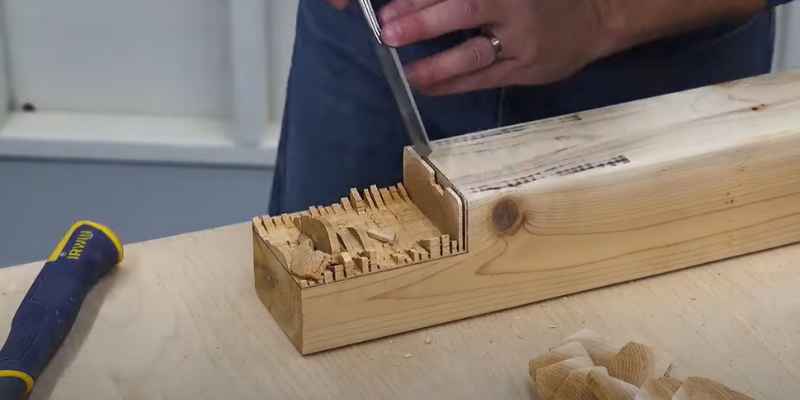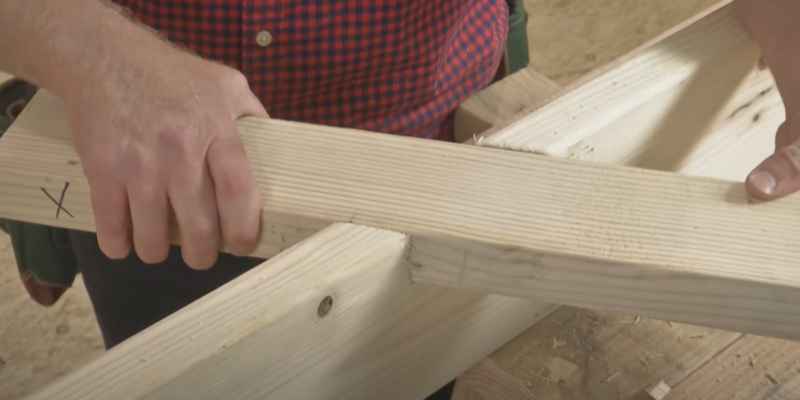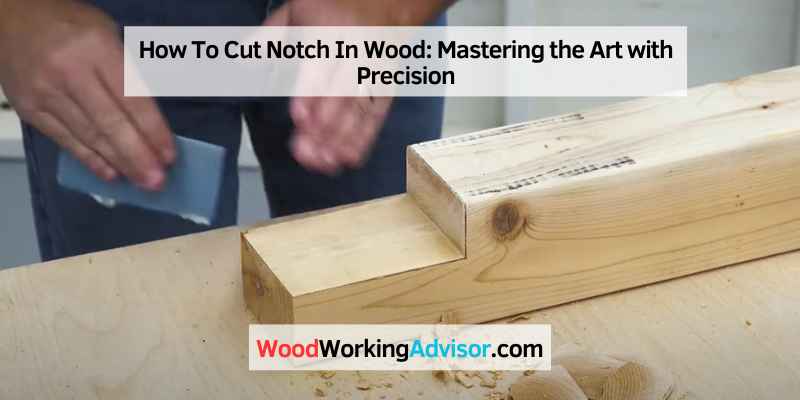To cut a notch in wood, measure and mark the desired location, make a straight cut with a saw, and then chisel out the remaining material for a clean and precise notch. Are you looking to cut a notch in wood for a specific project or woodworking task?
Knowing how to cut a notch in wood is a valuable skill that can be useful for various applications, such as creating joints or fitting pieces together. Whether you are a seasoned woodworker or a DIY enthusiast, this guide will provide you with step-by-step instructions on how to cut a notch in wood accurately and efficiently.
By following these simple and straightforward steps, you will be able to create clean and precise notches in your wooden pieces, helping you achieve professional-looking results. So let’s dive in and learn how to cut a notch in wood!
Understanding Notches In Wood
Understanding notches in wood is essential for any woodworking project. Notches are specialized cuts made in wood to create joints or connections between different pieces of wood. These joints provide strength and stability to the overall structure and ensure the longevity of the project. In this article, we will explore the different types of notches commonly used, the importance of notches in woodworking, and how to cut them correctly.
Different Types Of Notches
There are several types of notches that woodworkers frequently use depending on the specific requirements of their project:
| Notch Type | Description |
|---|---|
| Dovetail Notch | A notch with interlocking “tails” and “pins” that provide exceptional strength and are commonly used in fine woodworking and furniture making. |
| Half-Lap Notch | A simple, yet effective notch where half the thickness of each piece is removed, allowing them to overlap and create a flush joint. |
| Mortise and Tenon | A popular and sturdy joint where a projection (tenon) on one piece of wood fits into a hole (mortise) on the other piece, creating a strong connection. |
These are just a few examples of the various notches used in woodworking. Each type has its own unique characteristics and applications, and choosing the right one depends on factors such as the type of wood, the desired strength, and the overall design of the project.
Importance Of Notches In Woodworking
Notches play a crucial role in woodworking and are vital for achieving strong and durable joints. Here are some reasons why notches are of utmost importance:
- Strength: Notches greatly enhance the strength of joints, preventing the pieces of wood from separating or weakening over time.
- Stability: Properly cut notches ensure stability in the overall structure of a woodworking project, making it more reliable and safe.
- Durability: By creating precise connections between wood pieces, notches contribute to the longevity of the project, ensuring it withstands regular wear and tear.
- Visual Appeal: Well-executed notches can also add an aesthetic element to a woodworking project, showcasing the craftsmanship and attention to detail.
By understanding the different types of notches available and recognizing their importance, woodworkers can make informed decisions about the appropriate notches to use in their projects. Cutting notches correctly is essential for achieving secure and reliable joints, and we will explore the techniques in detail in the upcoming sections.

Essential Tools And Materials
When it comes to cutting notches in wood, having the right tools and materials is essential. This ensures that you can make precise and clean cuts without damaging the wood or risking injury. In this section, we will discuss the types of saws you can use, safety equipment to protect yourself, and the right type of wood that is suitable for notching.
Types Of Saws For Cutting Notches
If you are wondering what kind of saw to use for cutting notches in wood, there are a few options to consider. Each type of saw has its own advantages and is suitable for different projects. Here are three common types of saws:
- Crosscut Saw: This saw has a straight blade with sharp teeth and is perfect for making straight cuts across the wood grain. It is ideal for cutting notches in larger pieces of wood.
- Backsaw: This saw has a reinforced back and fine teeth, allowing for precise and controlled cuts. It is commonly used for cutting smaller notches and detailed work.
- Bandsaw: If you have access to a bandsaw, it can be a great tool for cutting notches in wood. This versatile tool allows for curved and intricate cuts, making it ideal for more complex notch designs.
Safety Equipment
When working with tools and sharp blades, safety should always be a top priority. Here are some essential safety equipment and gear to consider:
- Safety goggles: Protect your eyes from flying wood chips and debris by wearing safety goggles. This is especially important when using power tools.
- Dust mask: Woodworking produces dust particles that can be harmful when inhaled. Wearing a dust mask helps protect your lungs from potential health risks.
- Gloves: Invest in a good pair of gloves to protect your hands from cuts and splinters.
- Hearing protection: Some saws can be quite loud, so it is wise to wear ear protection to prevent hearing damage.
Choosing The Right Wood For Notching
Not all types of wood are suitable for cutting notches. When choosing the right wood, you should consider its hardness, grain pattern, and stability. Here are some types of wood commonly used for notching:
| Wood Type | Description |
|---|---|
| Oak | Durable and dense, oak is suitable for larger notches and heavy-duty projects. |
| Pine | Soft and easy to work with, pine is great for smaller notches and intricate designs. |
| Maple | Known for its strength and stability, maple is a popular choice for notching. |
| Cherry | With its attractive grain pattern, cherry wood is often used for decorative notches. |
By choosing the right wood, you can ensure that your notches are clean and durable, enhancing the overall look and function of your woodwork.
Step-by-step Guide To Cutting Notches
When it comes to woodworking, cutting notches is a fundamental skill you need to learn. Whether you’re building furniture or constructing a deck, notches are essential for creating strong and secure joints. In this step-by-step guide, we will walk you through the process of cutting notches in wood, from measuring and marking the wood to fine-tuning the notch for a perfect fit. Let’s dive in!
Measuring And Marking The Wood
The first step in cutting a notch in wood is measuring and marking the area where the notch will be located. Use a measuring tape to determine the precise length and width of the notch, ensuring it aligns with your project’s specifications. Once you have the measurements, mark the wood using a pencil or a marking knife. This will serve as your guide throughout the cutting process.
Setting Up The Saw
Next, it’s time to set up your saw according to the type of notch you are cutting. If you’re making a linear notch, such as a dado or a groove, a table saw or a dado blade attachment on a circular saw would be ideal. For more intricate notches, like a mortise or a dovetail joint, you may need a chisel and a mallet in addition to the saw. Make sure your saw is properly adjusted, and the blade is sharp to achieve clean and accurate cuts.
Making The Initial Cuts
Now it’s time to make the initial cuts to create the shape of the notch. Start by aligning the saw blade with the marked lines on the wood. Slowly and steadily, push the saw forward, letting the blade do the work. Take your time and maintain a steady hand to ensure precise cuts. For curved notches, consider using a jigsaw or a coping saw for better maneuverability. Remember to wear safety goggles and gloves to protect yourself during this process.
Removing The Waste Material
Once the initial cuts are made, it’s time to remove the waste material within the notch. To do this, use a chisel or a router, depending on the size and depth of the notch. Position the chisel or router bit at the edge of the notch and gently tap or guide it deeper into the wood in small increments. Be careful not to remove too much material at once to avoid any accidental damage. Repeat this process until all the waste material is cleared, leaving a clean and defined notch.
Fine-tuning The Notch
After removing the waste material, you may notice that the notch needs some fine-tuning for a perfect fit. This step involves using sandpaper, a file, or a chisel to carefully smooth and adjust the edges of the notch until they fit snugly with the corresponding piece. Take your time during this step to achieve a seamless fit. Test the fit regularly and make adjustments as needed until the notch is precisely shaped and ready for assembly.
Tips And Techniques For Precision
When it comes to cutting notches in wood, precision is key. To ensure accurate and clean cuts, there are several tips and techniques that can greatly improve your results. By maintaining a steady hand, using guides for accuracy, selecting the proper blade, and avoiding common mistakes, you can achieve the precision you desire in your woodworking projects.
Maintaining A Steady Hand
One of the most important aspects of cutting notches in wood is maintaining a steady hand. This can be done by maintaining a relaxed grip on the tool and taking slow, controlled motions. By keeping your hand steady, you avoid the risk of the saw slipping and creating an uneven cut. Additionally, using a guide or a support block can provide stability and further assist in keeping your hand steady during the cutting process.
Using Guides For Accuracy
To achieve precise notches, using guides is essential. Guides can take different forms, such as a miter gauge or a fence, depending on the type of cut you are making. These guides help in keeping the wood in place and providing a reference point for accurate cuts. By aligning the wood with the guide and securely holding it in place, you can ensure that your cuts are straight and consistent throughout the project.
Proper Blade Selection
The blade you choose for cutting notches in wood can make a significant difference in the precision of your cuts. When selecting a blade, consider the type of wood you are working with, its thickness, and the type of cut you are making. A blade with a smaller tooth count works well for rough cuts, while a blade with a higher tooth count is better for smoother, more precise cuts. Remember to always use a sharp blade to avoid splintering or tearing the wood fibers.
Avoiding Common Mistakes
There are a few common mistakes that can lead to imprecise notches in wood. One of these is applying too much force when cutting, which can cause the saw to deviate from the intended path. It’s important to let the tool do the work and guide it gently through the wood. Additionally, rushing through the cutting process can lead to sloppy cuts, so take your time and remain focused. Finally, double-check your measurements and markings before starting the cut to avoid any errors that could throw off your precision.
By following these tips and techniques for precision when cutting notches in wood, you can achieve clean, accurate cuts that enhance the quality of your woodworking projects. Remember to maintain a steady hand, use guides for accuracy, select the proper blade, and avoid common mistakes. With practice and attention to detail, you’ll soon be mastering the art of precise notching in wood.
Advanced Notching Techniques
When it comes to woodworking, cutting notches in wood is a fundamental skill. Notching allows you to create joints and connections between pieces of wood, providing structural stability and aesthetic appeal to your projects. While basic notching techniques are essential for most woodworking projects, advanced notching techniques can take your craftsmanship to a whole new level. In this article, we will explore three advanced notching techniques: compound notches, curved notches, and decorative notches.
Compound Notches
Compound notches are a versatile technique that involves cutting notches at different angles, combining multiple cuts to create a complex joint. These notches are commonly used in woodworking projects where two or more pieces of wood need to be joined at different angles, such as for constructing chairs, tables, or frames. To create a compound notch, follow these steps:
- Measure and mark the desired position of the notch on each piece of wood.
- Use a marking gauge or a square to transfer the notch measurements accurately.
- Secure the wood pieces firmly using clamps or a vise to ensure stability during the cutting process.
- Using a jigsaw or a coping saw, carefully cut along the marked lines, making sure to maintain the proper angle for each cut.
- After completing all the cuts, use a chisel or a file to refine and smooth out the surfaces of the notches.
Curved Notches
Curved notches add an artistic touch to your woodworking projects and can be used to create decorative elements or enhance the structural integrity of curved components. These notches require precision and attention to detail. To cut a curved notch:
- Draw the desired shape of the curved notch on the wood using a pencil or a marking tool.
- Drill a hole near the center of the marked shape to create an entry point for the jigsaw blade.
- Insert the jigsaw blade into the drilled hole and carefully cut along the marked shape, following the curve.
- Once the rough cut is complete, use a file or sandpaper to refine the edges of the notch, ensuring a smooth finish.
Decorative Notches
Decorative notches are an excellent way to add flair and personality to your woodworking projects. Whether you want to create intricate patterns, ornamental motifs, or unique designs, decorative notches allow you to showcase your creativity. Here are some techniques to consider:
- Using a router with a specialized bit, such as a cove or a roman ogee, to carve decorative profiles into the wood.
- Employing a chisel and mallet to manually carve intricate shapes and designs into the surface of the wood.
- Combining multiple cutting techniques, such as curved and compound notches, to create complex and eye-catching decorative elements.
Mastering advanced notching techniques opens up a world of possibilities for your woodworking projects. Whether you’re looking to enhance the functionality or aesthetics of your creations, compound notches, curved notches, and decorative notches can take your woodworking skills to the next level. Practice these techniques, experiment with different designs, and watch as your woodworking projects become true works of art!

Frequently Asked Questions On How To Cut Notch In Wood
What Is The Best Tool To Cut Notches In Wood?
The best tool for cutting notches in wood is a coping saw. It is easy to use and allows for precise cuts in various angles and depths.
How Do You Cut A Notch With A Jigsaw?
To cut a notch with a jigsaw, follow these steps:
1. Mark the desired notch on the material.
2. Clamp the material securely in place.
3. Hold the jigsaw firmly and align the blade with the marked notch.
4. Switch on the jigsaw and slowly guide the blade along the marked line.
5. Take regular breaks to prevent overheating of the jigsaw blade.
How Do You Notch A 4×4 For A 2×4?
To notch a 4×4 for a 2×4, use a saw or chisel to carefully remove a section of the 4×4 that matches the dimensions of the 2×4. This allows the 2×4 to fit securely within the notch, creating a strong joint.
Be sure to measure accurately and make smooth, straight cuts for a precise fit.
How Do You Cut Slits In Wood?
To cut slits in wood, follow these steps:
1. Mark the location of the slits on the wood.
2. Use a chisel or a router to create the slit.
3. Start by making a shallow cut, then gradually deepen it to the desired depth.
4. Take your time and work in small increments to avoid mistakes.
5. Use sandpaper to smooth the edges of the slits.
Conclusion
To conclude, cutting notches in wood may seem like a complex task, but with the right techniques and tools, it can be easily accomplished. By following the step-by-step process outlined in this post, you can achieve precise and clean notches that meet your woodworking needs.
Remember to prioritize safety, choose the right tool for the job, and practice your technique to improve your skills over time. With practice and persistence, you will become proficient at cutting notches in wood, opening up a world of possibilities for your woodworking projects.


